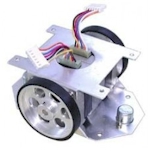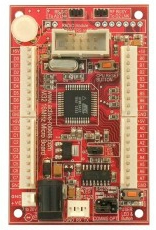RouteMaster Build
Chassis

RouteMaster uses a chassis based on 2 stepper motors placed back-to-back with aluminium wheels, and a simple sheet metal chassis holding it all together. The "floor" sheet bolts to the motors and has holes for the castors to sit in. The "roof" sheet has a large hole in the middle to allow the motor wiring to come through, and has a hole in each corner to mount circuit boards onto.
Current Switching

RM2012 has a power switch module for each motor. This allows for the low current chip signals to switch on (and off) the high current motor coils. The motor coils can draw up to about 2A on each coil, so transistors switch the current from the battery. The switching boards were purchased from
Active Robots. I use the "Easy-Step 1000" boards. The 1000 boards have no logic involved, they simply switch the login signals from the chip to the coils in the motors. The "Easy-Step 3000" has an on-board processor that handles all the functions of driving the motors (such as acceleration/deceleration etc), but where is the fun in that?! (They also cost �60 each, and I presume you need one per motor)!
Sensors

RM2012 uses 6 ultrasonic sensors (SRF05). Three are used at each end allowing the mouse to "ping" left, right and ahead. The mouse can then simply reverse, and by using the other 3 sensors meaning that it doesn't have to turn 180 degrees if stuck in a dead end. By using logical port numbers to call the sensors, the correct physical port can be addressed depending on the direction of travel. The units use 1 chip port to trigger the action, and to return the resulting distance signal back again. Once downside to these sensors is that you need to allow for about 40ms between pings to allow each ping to die away.
Microprocessor

RM012 currently uses the ATmega32 Development Board from
Active Robots as the main controller board. This board has an Atmel Mega32 chip onboard, which provides 32K flash memory, 2K SRAM, 1K EEPROM all running at 16Mhz. The board/chip has up to 3 timers, A/D converters, ISP, Power & 1 user LEDs, User button, pull-up resistors, 31 I/O ports, built-in RS232 connection etc etc. It will be a useful way of developing the basic mouse functions. Eventually I will replace the board with my own circuit and probably use a Mega32 or Mega16 chip.
 RouteMaster uses a chassis based on 2 stepper motors placed back-to-back with aluminium wheels, and a simple sheet metal chassis holding it all together. The "floor" sheet bolts to the motors and has holes for the castors to sit in. The "roof" sheet has a large hole in the middle to allow the motor wiring to come through, and has a hole in each corner to mount circuit boards onto.
RouteMaster uses a chassis based on 2 stepper motors placed back-to-back with aluminium wheels, and a simple sheet metal chassis holding it all together. The "floor" sheet bolts to the motors and has holes for the castors to sit in. The "roof" sheet has a large hole in the middle to allow the motor wiring to come through, and has a hole in each corner to mount circuit boards onto.
 RM2012 has a power switch module for each motor. This allows for the low current chip signals to switch on (and off) the high current motor coils. The motor coils can draw up to about 2A on each coil, so transistors switch the current from the battery. The switching boards were purchased from Active Robots. I use the "Easy-Step 1000" boards. The 1000 boards have no logic involved, they simply switch the login signals from the chip to the coils in the motors. The "Easy-Step 3000" has an on-board processor that handles all the functions of driving the motors (such as acceleration/deceleration etc), but where is the fun in that?! (They also cost �60 each, and I presume you need one per motor)!
RM2012 has a power switch module for each motor. This allows for the low current chip signals to switch on (and off) the high current motor coils. The motor coils can draw up to about 2A on each coil, so transistors switch the current from the battery. The switching boards were purchased from Active Robots. I use the "Easy-Step 1000" boards. The 1000 boards have no logic involved, they simply switch the login signals from the chip to the coils in the motors. The "Easy-Step 3000" has an on-board processor that handles all the functions of driving the motors (such as acceleration/deceleration etc), but where is the fun in that?! (They also cost �60 each, and I presume you need one per motor)!
 RM2012 uses 6 ultrasonic sensors (SRF05). Three are used at each end allowing the mouse to "ping" left, right and ahead. The mouse can then simply reverse, and by using the other 3 sensors meaning that it doesn't have to turn 180 degrees if stuck in a dead end. By using logical port numbers to call the sensors, the correct physical port can be addressed depending on the direction of travel. The units use 1 chip port to trigger the action, and to return the resulting distance signal back again. Once downside to these sensors is that you need to allow for about 40ms between pings to allow each ping to die away.
RM2012 uses 6 ultrasonic sensors (SRF05). Three are used at each end allowing the mouse to "ping" left, right and ahead. The mouse can then simply reverse, and by using the other 3 sensors meaning that it doesn't have to turn 180 degrees if stuck in a dead end. By using logical port numbers to call the sensors, the correct physical port can be addressed depending on the direction of travel. The units use 1 chip port to trigger the action, and to return the resulting distance signal back again. Once downside to these sensors is that you need to allow for about 40ms between pings to allow each ping to die away.
 RM012 currently uses the ATmega32 Development Board from Active Robots as the main controller board. This board has an Atmel Mega32 chip onboard, which provides 32K flash memory, 2K SRAM, 1K EEPROM all running at 16Mhz. The board/chip has up to 3 timers, A/D converters, ISP, Power & 1 user LEDs, User button, pull-up resistors, 31 I/O ports, built-in RS232 connection etc etc. It will be a useful way of developing the basic mouse functions. Eventually I will replace the board with my own circuit and probably use a Mega32 or Mega16 chip.
RM012 currently uses the ATmega32 Development Board from Active Robots as the main controller board. This board has an Atmel Mega32 chip onboard, which provides 32K flash memory, 2K SRAM, 1K EEPROM all running at 16Mhz. The board/chip has up to 3 timers, A/D converters, ISP, Power & 1 user LEDs, User button, pull-up resistors, 31 I/O ports, built-in RS232 connection etc etc. It will be a useful way of developing the basic mouse functions. Eventually I will replace the board with my own circuit and probably use a Mega32 or Mega16 chip.